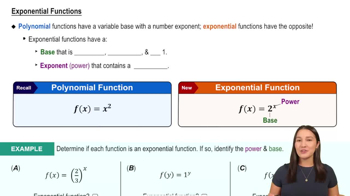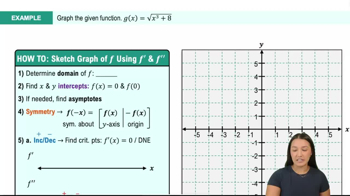Table of contents
- 0. Functions7h 52m
- Introduction to Functions16m
- Piecewise Functions10m
- Properties of Functions9m
- Common Functions1h 8m
- Transformations5m
- Combining Functions27m
- Exponent rules32m
- Exponential Functions28m
- Logarithmic Functions24m
- Properties of Logarithms34m
- Exponential & Logarithmic Equations35m
- Introduction to Trigonometric Functions38m
- Graphs of Trigonometric Functions44m
- Trigonometric Identities47m
- Inverse Trigonometric Functions48m
- 1. Limits and Continuity2h 2m
- 2. Intro to Derivatives1h 33m
- 3. Techniques of Differentiation3h 18m
- 4. Applications of Derivatives2h 38m
- 5. Graphical Applications of Derivatives6h 2m
- 6. Derivatives of Inverse, Exponential, & Logarithmic Functions2h 37m
- 7. Antiderivatives & Indefinite Integrals1h 26m
- 8. Definite Integrals4h 44m
- 9. Graphical Applications of Integrals2h 27m
- 10. Physics Applications of Integrals 2h 22m
5. Graphical Applications of Derivatives
Curve Sketching
Problem 4.R.34
Textbook Question
24–34. Curve sketching Use the guidelines given in Section 4.4 to make a complete graph of the following functions on their domains or on the given interval. Use a graphing utility to check your work.
{Use of Tech} ƒ(x) = x (x -1)e⁻ˣ
 Verified step by step guidance
Verified step by step guidance1
Identify the domain of the function. Since the function is a product of polynomials and an exponential function, it is defined for all real numbers.
Find the first derivative, f'(x), to determine the critical points and intervals of increase and decrease. Use the product rule and chain rule: f'(x) = d/dx [x(x-1)e^(-x)].
Set the first derivative equal to zero to find critical points: f'(x) = 0. Solve for x to find where the function changes from increasing to decreasing or vice versa.
Find the second derivative, f''(x), to determine concavity and points of inflection. Use the product rule and chain rule again: f''(x) = d/dx [f'(x)].
Analyze the behavior of the function as x approaches positive and negative infinity to determine end behavior. Consider the limits of f(x) as x approaches infinity and negative infinity.
 Verified video answer for a similar problem:
Verified video answer for a similar problem:This video solution was recommended by our tutors as helpful for the problem above
Video duration:
15mPlay a video:
Was this helpful?
Key Concepts
Here are the essential concepts you must grasp in order to answer the question correctly.
Curve Sketching
Curve sketching involves analyzing a function's behavior to create a visual representation of its graph. This includes determining key features such as intercepts, asymptotes, intervals of increase and decrease, and concavity. By applying calculus concepts like derivatives, one can identify critical points and inflection points, which are essential for accurately sketching the curve.
Recommended video:

Summary of Curve Sketching
Derivatives
Derivatives represent the rate of change of a function and are fundamental in understanding its behavior. By finding the first derivative, one can determine where the function is increasing or decreasing, while the second derivative helps identify concavity and points of inflection. These insights are crucial for sketching the graph accurately and understanding the function's overall shape.
Recommended video:

Derivatives
Exponential Functions
Exponential functions, such as e^(-x), exhibit unique properties, including rapid growth or decay. In the given function f(x) = x(x - 1)e^(-x), the exponential component influences the function's behavior as x approaches infinity or negative infinity. Understanding how exponential functions interact with polynomial terms is essential for predicting the function's end behavior and overall graph shape.
Recommended video:

Exponential Functions

 11:41m
11:41mWatch next
Master Summary of Curve Sketching with a bite sized video explanation from Callie
Start learning



